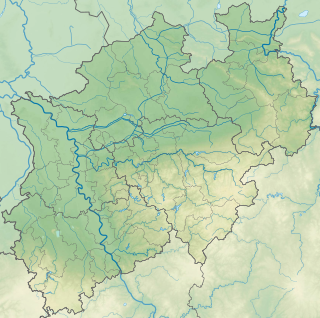Sundern forests
| Sundern forests | |||
|---|---|---|---|
| The Hellefelder Höhe on the southern edge of the Sundern forests | |||
| Systematics according to | Handbook of the natural spatial structure of Germany | ||
| Greater region 1st order | Low mountain range threshold | ||
| Greater region 2nd order | Rhenish Slate Mountains | ||
| Main unit group | 33 → Süderbergland |
||
| About main unit | 334 → North Sauerland Oberland |
||
| Natural space |
334.0 → Sundern Forests |
||
| Geographical location | |||
| Coordinates | 51 ° 21 '7 " N , 8 ° 2' 20" E | ||
|
|||
| local community | Sundern (Sauerland) , Arnsberg , Balve | ||
| state | North Rhine-Westphalia | ||
| Country | Germany | ||
The Sundern forests are a natural spatial unit with the order number 334.0 within the North Sauerland Oberland (334). They include, according to the manual of the natural spatial structure of Germany almost completely forested, from Upper Carboniferous shales existing hull mountains in the north of the city of Sundern with smaller parts of Balve the west and Arnsberg the north and form a release barrier between the predominantly open Hachener tip land (337 2 .8 ) and the Inner Sauerland Sinks (335). The largest settlements in the natural environment are the main town and Sundern Langscheid at the beginning of the storage Sorpetalsperre , which is also completely in the natural environment.
In the Sundern forests, the upper carbon slate area of the Arnsberg Forest merges in a south-westerly direction across the Ruhr into the Lüdenscheider Mulde (336 1 .6 / 8). As in the Arnsberg Forest, the subsoil consists of folded clay and greywacke slates from the Arnsberg strata . The soils in the natural area are usually shallow and consist of low-base sandy-loamy to clayey weathering products, which are covered in shallower areas with a thin, decalcified layer of loess . Waterlogged soils have formed in the dents and valleys .
The greatest heights with around 500 m above sea level. NN are located in the southeast of the natural area, where the flanks of the Hellefelder Berg ( 502.8 m above sea level ) drop steeply to the Hellefeld Depression (335.6) in the Innersauerland Depression. To the northwest , the terrain gradually extends to around 300 m above sea level. NN at Rohnscheid and in the Hachener Mark .
The Rump Mountains are structured by the moderately sloping bottom valleys of the Sorpe and the Röhr , both of which arise from the Homertrücken (336 1 .2), which are cut into gently rounded ridges . Geologically, the two largest rivers in the natural area differ from the smaller rivers, as they do not follow the valleys of the mountains unfolded by the Variscan Orogeny , but break through in valleys 150 to 200 m deep. The Sorpe dam was built in the breakthrough valley of the Sorpe.
The climate is damp and cool with 950 mm annual precipitation and a May / July mean temperature of 13 to 14 ° C. In combination with the soil, this offers a good basis for the development of beech forests . However, these have been largely displaced by the forestry cultivation of coniferous forests.

